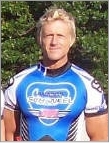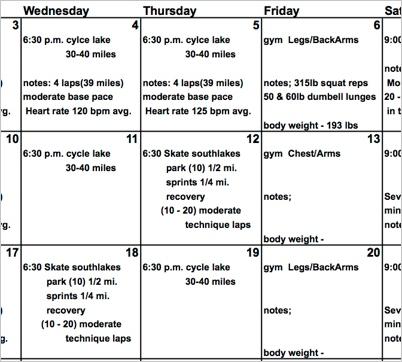This week's tip:
Creating Your Training Plan
Step 3: Creating your training schedule
By Alex Fedak
You are almost there!
You’ve set your goals (Step 1). You've figured out what you need to do to reach them (Part 2).
All you've got to do now is create your training schedule, and that's where the fun really starts.
There are just two basic steps to creating a training schedule:
First, decide when you are going to do the things on your to-do list.
Second, record everything in a calendar.
That’s all there is to it!
What kind of calendar to use?
You can use any kind of calendar. Most people use a wall calendar or the digital calendar on their computer.
I prefer to make my own calendar using a spreadsheet program on my laptop. I create a separate “sheet” for each month and set up a calendar grid with a box for each day. (See pdf above.)
Within each box, I make text fields for my planned activities and for my post-workout notes.
Three examples
1) Simple
Let’s say your goal is to simply get in shape, and to reach this goal, you plan to skate for one hour, three times a week.
Start by deciding when you are going to go on your skates. Let’s say 4 p.m. Tuesdays, 4 p.m. Thursdays and 9 a.m. Saturdays.
Then, schedule the workouts in your calendar.
This is simple with a digital calendar. Just create three recurring events, one each for Tuesdays, Thursdays and Saturdays.
If you are using a paper calendar, you will have to write in the workouts on each Tuesday, Thursday and Saturday for as long as your plan continues.
2) Weight loss
If your plan is to lose weight, you do much the same thing. Log all your planned workouts. Record your starting weight and schedule a weekly weigh in. Then record the number of calories you consume each day and the number of calories you burn. And watch the weight go.
3) Racing
Like most competitive skaters, my training plan includes a bunch of stuff: base training, weight lifting, sprint training, tapering, etc. At times, all this can seem overwhelming. But once I put everything into my training schedule, I wonder what all the fuss was about.
Start by scheduling all your races. After all, they are the focus of your training. Then add your rest and travel days. Finally, schedule your workouts.
As an example, I’ll use my training schedule for January. My focus at the beginning of the season is building my base conditioning, so I start with lots of long, slow distance training.
The winters in Oklahoma are harsh. So I do most of this training on a bike. I schedule three long-distance rides or skates a week: one each on Tuesday, Wednesday and Thursday.
On Friday, I do my weight training. On Saturday, I get some more distance training with a long ride with my cycling team. On Sunday, I attend practice with my indoor team in Wichita.
Of course, you have to be flexible. For instance, at the end of January, I have an indoor meet on Saturday and Sunday. So I moved my rest day to the Friday before the meet and postponed my weight training until the Monday after.
As the season progresses, I start doing more interval and sprint training to get myself ready for my big outdoor races.
Making changes
Training plans are not written in stone. As you work through them, you find that some things work, others don't, and inevitably you run across new things to try.
So feel free to revise your training schedule as you go along. There's no harm in this. The important thing is that you keep training and working toward your goals.
Think of your training plan as a contract with the universe. You agree to do certain things. In exchange, the universe — if it likes your plan — agrees to let you enjoy some success.
And here’s the good news: if you keep working your plan, eventually the universe will let you succeed.
...
 Alex Fedak is one of America’s top pro skaters. In recent years, he has notched top five finishes in Saint Paul, Ottawa, Houston, San Diego and Round Rock. He is also a Category 3 road cyclist and an accountant for Oklahoma City. “I have been skating since I was very young, starting on quads and then transitioned to inlines in the early 90’s,” he says. “My first inline race was in 2003 at a local Oklahoma City event. Then I branched out to Texas. Since then, I have averaged five to seven inline races a year.” A member of Simmons Racing, he trains with hometown buddy and teammate Rob Bell.
Alex Fedak is one of America’s top pro skaters. In recent years, he has notched top five finishes in Saint Paul, Ottawa, Houston, San Diego and Round Rock. He is also a Category 3 road cyclist and an accountant for Oklahoma City. “I have been skating since I was very young, starting on quads and then transitioned to inlines in the early 90’s,” he says. “My first inline race was in 2003 at a local Oklahoma City event. Then I branched out to Texas. Since then, I have averaged five to seven inline races a year.” A member of Simmons Racing, he trains with hometown buddy and teammate Rob Bell.
